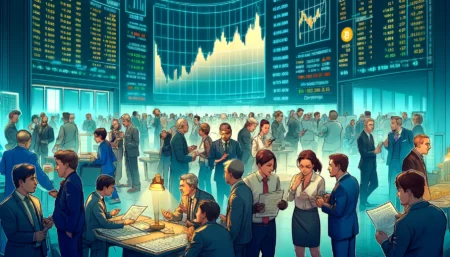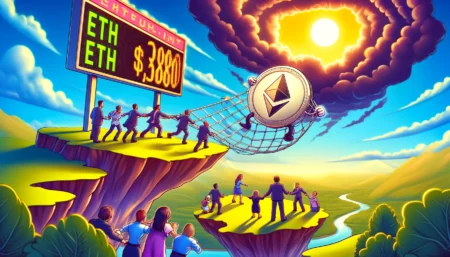In 2022, it will be difficult to act without encountering the term metaverse. Following Facebook’s rebranding at the end of 2021, nearly every company is eager to let us know their vision for a digital world where we can work, play and socialize on a virtual platform.
However, anyone who has been following the Metaverse will realize that these visions are often very different. While Meta focuses on creating virtual reality environments, companies like Microsoft and Nvidia are developing metaverse environments for collaboration and digital projects.
At the same time, those who believe that the future of the internet is decentralized and built on blockchain are experimenting with non-fungible tokens (NFTs) to enable ownership of digital assets, as well as to bring digital democracy to the virtual world The Decentralized Autonomous Organization (DAO) of the world we live in.
The metaverse concept is expected to add $5 trillion in value to the global economy by 2030, and 2023 could be a pivotal year in determining its direction.
Trend 1: metaverse as a new marketing channel
Like search engines and social media (technological enablers of web 1.0 and 2.0), marketing and advertising will provide the fuel that propels the metaverse into the mainstream.
The concept may not yet be fully integrated, but businesses from international financial giants like HSBC and JPMorgan, global lifestyle and fashion giants like Nike and Gucci have made their case and are starting to build their virtual worlds.
The appeal is obvious, and we know that consumers are always looking for new, more engaging ways to connect with the brands they want to do business with.
Metaverse focuses on customer experience and one-to-one connections, another communication channel. Crucially, it’s not as well stitched together as social and search have been by the likes of Google and Meta, there’s still turf here to contend with.
Over the next 12 months, businesses are going all out to position themselves in gold-level virtual locations, whether by building their own platforms, or capturing existing areas like Meta Horizons, Fortnite, VR Chat, or Decentraland.
The appeal is obvious, and we know that consumers are always looking for new, more engaging ways to connect with the brands they want to do business with.
Metaverse focuses on customer experience and one-to-one connections, another communication channel. Crucially, it’s not as well stitched together as social and search have been by the likes of Google and Meta, there’s still turf here to contend with.
Over the next 12 months, businesses are going all out to position themselves in gold-level virtual locations, whether by building their own platforms, or capturing existing areas like Meta Horizons, Fortnite, VR Chat, or Decentraland.
Trend 2: enterprise metaverse
In addition to its power as a marketing tool, Metaverse promises to provide platforms, tools and entire virtual worlds that allow business to be done remotely, efficiently and intelligently.
We can expect to see the concept of the metaverse merge with the concept of digital twins, virtual simulations of real-world products, processes or operations that can be used to test and prototype new ideas in a secure environment in the digital realm. From wind farms to Formula 1 race cars, designers are recreating physical objects in virtual worlds, whose efficiency can be stress-tested under any conceivable conditions, without the resource cost of testing in the physical world.
Another use of metaverse technology in the corporate world is for training, onboarding, and other tasks. Consulting giant Accenture, for example, created a metaverse environment called The Nth Floor that features a replica of a real-world office and allows employees and new hires to perform many HR-related functions in the virtual world.
Metaverse collaborative work environments, such as the BMW Augmented Reality Lab for designing and prototyping new products, will also become more popular as teams research new ways to work remotely while maintaining interaction with colleagues and their creative process.
Trend 3: Web3 and decentralization
One vision of the form the Metaverse will eventually take revolves around decentralization. According to proponents of Web 3.0, distributed ledgers and blockchain technology will give rise to a new internet not controlled by global corporations that will no longer have the power to censor opinions they disagree with or unplug if they want The power of the plug to take someone completely offline.
This vision is built around decentralized metaverse platforms such as The Sandbox and Decentraland that will eventually be organized as DAOs. Buying ownership will give individuals a say in how the organization building the virtual domain operates, which will ultimately lead to the creation of virtual democracies and user-owned communities.
NFTs are another aspect of the decentralized metaverse. These are unique tokens that exist on the blockchain, just like non-unique tokens like cryptocurrencies such as Bitcoin BTC 1.34%, that can be used to represent unique online items or commodities.
Brands including Nike, Adidas and Forever 21 have used the technology to create digital goods that can be worn, traded and displayed in virtual worlds by their owners. Another footwear brand, Clarks, recently launched an online tournament using the Roblox platform, where users can win unique virtual goods.
The vision of the Metaverse as a decentralized, community-owned utopia is somewhat at odds with the vision advocated by companies like Meta and Microsoft, which aim to build their own proprietary digital universes that they will have absolute control over. 2023 may bring more interesting developments in this clash of digital cultures.
Trend 4: virtual and augmented reality
The idea of immersive, experiential technology is at the heart of the metaverse – whatever it ends up looking like, it will be more engaging than the digital world we’re used to today (like Facebook or the World Wide Web). So many ideas of how we’ll interact with it involve immersive technologies such as virtual reality (VR), augmented reality (AR), and mixed/extended reality (MR/XR).
Meta has established a concrete vision for the next level of the Internet of Virtual Reality, with a new version of its popular Quest VR headset coming in 2023, as well as new VR/AR/MR headsets from companies like this one.
While not everyone agrees that entering a virtual world requires us to fix our monitors in front of our eyes, it is certainly one of the ways to build immersive experiences and will create the most exciting scenarios, and 2023 will bring many new development.
Beyond headsets, we can expect to see new developments in full-body haptic suits, which are already being used by organizations like NASA and SpaceX to simulate extreme environments, but will also be used to create more realistic and immersive consumers Virtual world experiences, several startups are even experimenting with technology that can introduce scents into our virtual experiences!
Trend 5: more advanced avatar technology
Much of the idea that the metaverse will involve us adopting avatars that represent us in the digital world. Just as we are used to playing characters in video games or expressing our characters in social media, avatars are beings that we project as we interact and interact with other users, who may look like us, or like cartoon characters, or like Something totally fantastic that would never exist in the real world!
Meta initially only offered very basic cartoon avatars – which was widely mocked, but more recently near-realistic technology has been developed that will make us look almost exactly as we do in the real world.
Other technologies, such as Ready Player Me and Zepeto, also allow us to create avatars that can then be placed into many different virtual worlds and environments, rather than being tied to a specific platform.
Predicting that in 2023, we will see more advanced technology use cases, such as motion capture, meaning that in addition to looking and sounding more like us, our avatars will adopt our own unique gestures and body language.
We may even begin to see further developments in the field of autonomous avatars, meaning that they will not be under our direct control, but will instead be our representation in the digital world through artificial intelligence, with ourselves completely unrelated to the rest people get along with tasks.






